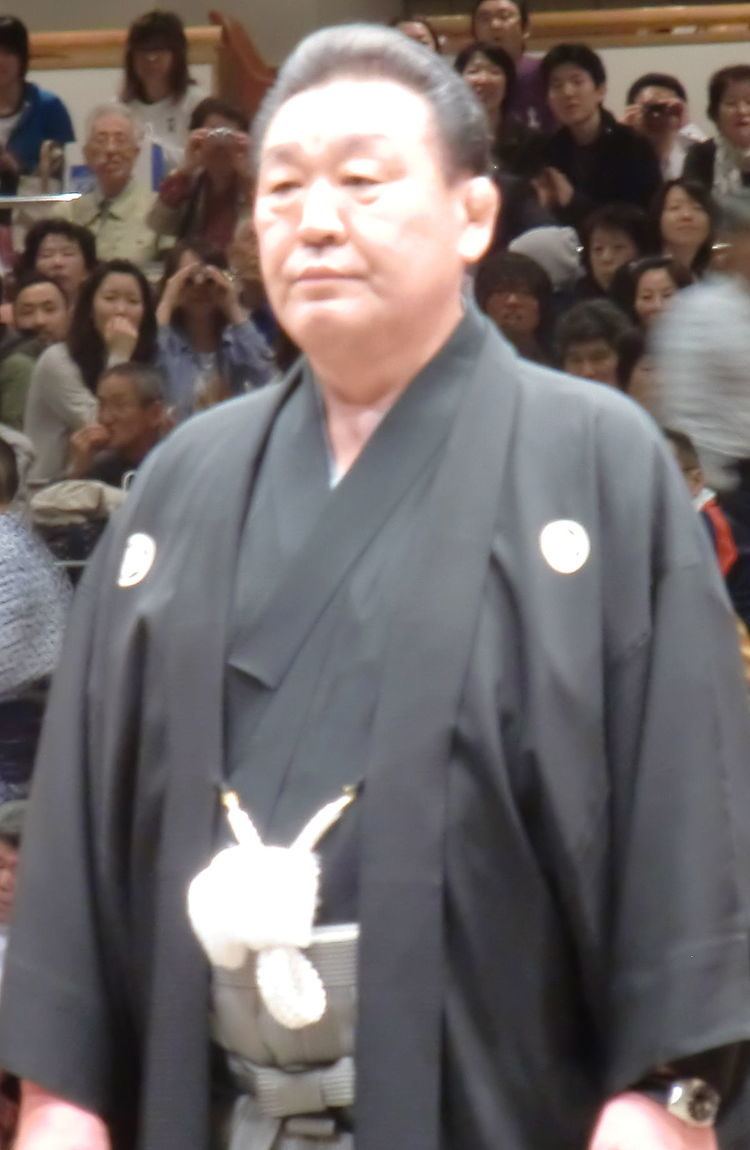
Record 695-525-56 (1 draw) Name Mienoumi Tsuyoshi Weight 136 kg Retired November, 1980 Height 1.80 m | Makuuchi rank Yokozuna Debut July, 1963 Role Sumo Wrestler Children Toshiaki Ishiyama | |
Born Goro Ishiyama February 4, 1948 (age 77) Matsusaka, Mie, Japan ( 1948-02-04 ) Championships 3 (Makuuchi)1 (Sandanme) Special Prizes Outstanding Performance (5)Fighting Spirit (1)Technique (3) Stable Dewanoumi stable (1963–1980) | ||
Highest rank Yokozuna (July, 1979) Similar Chiyonofuji Mitsugu, Yamamotoyama Ryūta, Takayasu Akira | ||
Mienoumi Tsuyoshi (三重ノ海 剛司, Mienoumi Tsuyoshi) (born February 4, 1948 as Gorō Ishiyama (石山五郎, Ishiyama Gorō) is a former champion sumo wrestler, the 57th yokozuna of the sport. He is the founder of Musashigawa stable and a former chairman of the Japan Sumo Association. He was born in Matsusaka, Mie, Japan.
Contents

Career
His father was a construction worker who competed in amateur sumo tournaments. The young Mienoumi did judo at junior high school and was introduced to a coach at Dewanoumi stable, but was initially rejected due to his short stature. He contacted the stable again a few years later, and this time was accepted by Dewanoumi Oyataka himself, the former Dewanohana Kuniichi. His first bout was in July 1963, aged just 15. At first fighting under his family name of Ishiyama, he switched to the shikona of Mienoumi in 1966. After being personally trained by the new Dewanoumi Oyakaya, former yokozuna Sadanoyama, he developed his technique and was promoted to jūryō division in March 1969, and makuuchi, the top division, in September 1969. In July of the following year, he reached the rank of komusubi, defeating two yokozuna (Taihō and Tamanoumi) and receiving his first prize (shukun-shō). He was promoted to sekiwake in the next tournament in September 1970.
He suffered from a chronic liver problem throughout his career, and although he tried to keep it under control by changing his diet, it was a factor in his eventual retirement.
In September 1974 his 11th day match with Futagodake was declared a draw (hikiwake). This is the last draw in the top division to date.
He won his first makuuchi tournament or yūshō in November 1975 and was promoted to ōzeki the following January. He lost a majority of bouts in the next two tournaments, resulting in an automatic demotion back to sekiwake, but a good result of 10 wins to 5 losses in the next tournament was sufficient to restore him to ōzeki.
In May 1979 he was a runner-up for the fourth time, to Wakanohana with a 13–2 record. He followed that up with a superb 14–1 record in the following tournament, defeating Wakanohana, Kitanoumi and Wajima, only losing the championship in a playoff to Wajima on the final day. In September 1979 he was finally promoted to yokozuna. The 97 tournaments it took him to do so is the slowest ever progress to sumo's top rank. His oyakata declared that he would be happy with just one more yūshō before Mienoumi's retirement. In the event, Mienoumi won his second and third tournaments as yokozuna, the latter with a perfect score, but after this had several absences due to injury and illness, fighting a full fifteen bouts in only four tournaments as yokozuna, before retiring in November 1980. He has the lowest win-loss ratio of any post-war yokozuna.
After retirement
Upon retirement Mienoumi took the name of Musashigawa Oyakata and established Musashigawa stable in 1981. Until then Dewanoumi stable had discouraged any breaking away, and he was the first from Dewanoumi in 62 years to amicably set up a new stable. By 2000 Musashigawa stable had become one of the strongest stables in sumo with a yokozuna, Musashimaru, and three ōzeki, Dejima, Musōyama and Miyabiyama. Musashigawa performed an early kanreki dohyō-iri in 2007 (normally performed on a yokozuna's 60th birthday) to mark the 25th anniversary of the founding of Musashigawa stable. On September 8, 2008, he became the chairman of the Japan Sumo Association following the resignation of Kitanoumi. One of his first actions was to demand a controversial tightening up of the rules for the tachi-ai, or initial charge, which led to many false starts in the September 2008 tournament. Following a series of scandals involving wrestlers gambling and associating with organised crime members, he was suspended for the July 2010 tournament and announced his resignation the following month. He also cited health concerns, as he had been undergoing treatment for stomach cancer. In September 2010 he also stood down as head of Musashigawa stable, although he remained a coach there. Former ōzeki Musōyama is now head coach of what is now Fujishima stable. In December 2012 he announced that the former Musashimaru would inherit his elder name when Musashigawa reached 65 years of age in February 2013. He is now director of the Sumo Museum at the Ryōgoku Kokugikan.
Fighting style
Mienoumi was a yotsu-sumo wrestler who preferred grappling techniques to pushing or thrusting. His favourite grip on his opponent's mawashi was hidari-yotsu, a left hand inside and right hand outside position. He regularly won by yori-kiri (force out) and uwatedashinage (pulling overarm throw).
